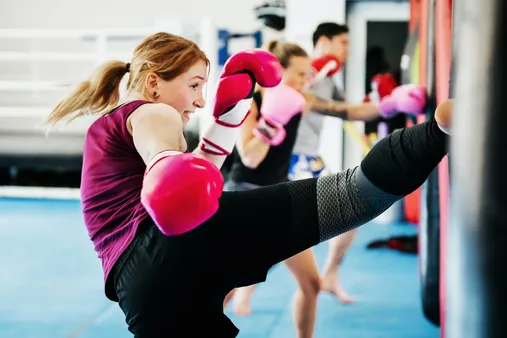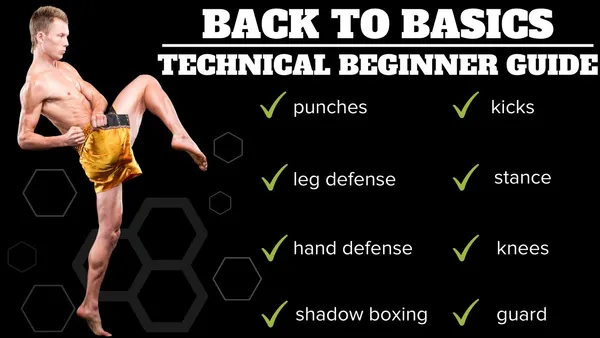Table of Contents
Kickboxing is a thrilling and comprehensive martial art that blends the dynamic techniques of boxing, karate, and Muay Thai. Embark on a journey with Kizworld to discover How to get started with kickboxing as a beginner. Whether your goal is to enhance your fitness, master self-defense skills, or step into the ring for competition, this comprehensive guide will equip you with the knowledge and skills to excel in kickboxing. From selecting the right gym to mastering fundamental techniques and advanced strategies, we'll guide you every step of the way. Get ready to unleash your inner warrior and delve into the world of kickboxing.
How to Get Started with Kickboxing as a Beginner: Your Step-by-Step Guide to Success
I. Basic techniques in kickboxing.
Stance
The basic stance in kickboxing is similar to the stance in boxing, with your feet shoulder-width apart, your knees slightly bent, and your hands up in front of your face. Your weight should be evenly distributed on both feet, and you should be relaxed and ready to move.
- Keep your feet shoulder-width apart.
- Bend your knees slightly.
- Keep your hands up in front of your face.
- Distribute your weight evenly on both feet.
- Relax and be ready to move.
Punches
The basic punches in kickboxing are the jab, the cross, the hook, and the uppercut. The jab is a straight punch thrown with your lead hand, the cross is a straight punch thrown with your rear hand, the hook is a looping punch thrown with your lead hand, and the uppercut is a short, upward punch thrown with your rear hand.
Punch | Description |
Jab | Straight punch thrown with your lead hand. |
Cross | Straight punch thrown with your rear hand. |
Hook | Looping punch thrown with your lead hand. |
Uppercut | Short, upward punch thrown with your rear hand. |
Kicks
The basic kicks in kickboxing are the front kick, the roundhouse kick, the side kick, and the back kick. The front kick is a straight kick thrown with your lead leg, the roundhouse kick is a circular kick thrown with your rear leg, the side kick is a sideways kick thrown with your lead leg, and the back kick is a backward kick thrown with your rear leg.
- Front kick: Straight kick thrown with your lead leg.
- Roundhouse kick: Circular kick thrown with your rear leg.
- Side kick: Sideways kick thrown with your lead leg.
- Back kick: Backward kick thrown with your rear leg.
Combinations
Once you have mastered the basic techniques of kickboxing, you can start to combine them into combinations. A combination is a series of punches and kicks thrown in quick succession. Combinations can be used to attack your opponent, defend yourself, or set up a knockout.
Here are some basic combinations that you can try:
- Jab-cross-hook
- Jab-cross-roundhouse kick
- Jab-cross-uppercut
- Front kick-roundhouse kick
- Side kick-back kick
As you get more experienced, you can start to develop your own combinations. The key is to be creative and to use your combinations to keep your opponent guessing.
Kickboxing is a great way to get in shape, learn self-defense, and have fun. If you're looking for a new workout, kickboxing is a great option.
To learn more about kickboxing, check out these related posts:
- How to Choose the Right Kickboxing Gym
- What to Expect in a Kickboxing Class
- The Benefits of Kickboxing for Fitness and Self-Defense
II. Protective gears for beginners in kickboxing.
Protective gears for beginners in kickboxing.
Choosing the Right Protective Gear
For a safe and enjoyable kickboxing experience, it's essential to invest in the right protective gear. This gear will protect you from injuries and allow you to train and spar with confidence. The most important pieces of protective gear for beginners include:
- Boxing gloves: These protect your hands and wrists while punching and blocking.
- Shin guards: These protect your shins and calves from kicks.
- Mouthguard: This protects your teeth and gums from impact.
- Headgear: This protects your head from punches and kicks.
- Groin protector: This protects your groin area from kicks and strikes.
- Hand wraps: These protect your hands and wrists from injury.
Choosing high-quality protective gear is important to ensure that it provides adequate protection and lasts for a long time. Look for gear that is made from durable materials and that fits properly.
Find the right protective gear for kickboxing here.
Proper Care and Maintenance
To keep your protective gear in good condition and extend its lifespan, it's important to properly care for and maintain it. This includes:
- Cleaning your gear regularly: Use a mild detergent and water to clean your gear after each use. Air dry it thoroughly before storing.
- Inspecting your gear for damage: Regularly inspect your gear for signs of wear or damage. Replace any damaged gear immediately.
- Storing your gear properly: Store your gear in a cool, dry place when not in use. Avoid exposing it to extreme temperatures or sunlight.
By following these tips, you can ensure that your protective gear remains in good condition and provides you with the protection you need while kickboxing.
Fitness Benefits | Self-Defense Benefits |
Improved cardiovascular health | Increased confidence and awareness |
Enhanced muscular strength and endurance | Improved reaction time and coordination |
Reduced stress and anxiety | Effective self-defense techniques |
By investing in the right protective gear, maintaining it properly, and following the guidelines for safe training, you can enjoy the benefits of kickboxing while minimizing the risk of injury.
Get started with kickboxing today.
III. Fitness requirements for kickboxing.
Fitness requirements for kickboxing.
Kickboxing requires a combination of strength, endurance, and agility. Strength is important for powerful strikes, while endurance is needed to maintain a high level of intensity during a fight. Agility is essential for evading your opponent's strikes and landing your own. If you're interested in getting started with kickboxing, here are some tips for improving your fitness:
- Start with a strength training routine that focuses on compound exercises like squats, deadlifts, and bench presses. These exercises will help you build muscle mass and improve your overall strength.
- Incorporate cardio into your training regimen. Kickboxing is a high-intensity activity, so it's important to have a strong cardiovascular system. Aim for at least 30 minutes of moderate-intensity cardio each week.
- Work on your agility with exercises like jumping jacks, ladder drills, and cone drills. These exercises will help you improve your coordination, balance, and reaction time.
- Stretch regularly to improve your flexibility. Flexibility is important for kicking and evading your opponent's strikes. Aim to stretch for at least 10 minutes before and after each workout.
Once you've improved your fitness, you can start learning the basics of kickboxing. There are many different techniques to learn, but some of the most common include:
- Punches: Jab, cross, hook, and uppercut.
- Kicks: Front kick, roundhouse kick, side kick, and back kick.
- Knee and elbow strikes.
- Defensive techniques like blocking, dodging, and countering.
Kickboxing is a challenging but rewarding martial art that can help you get in shape, learn self-defense, and have fun. If you're interested in giving it a try, be sure to talk to a qualified instructor who can help you get started.
Related posts: Kickboxing for Beginners: The Ultimate Guide to Getting Started, How to Choose the Right Kickboxing Class for You, Kickboxing Workouts for Beginners: A 4-Week Plan
Kickboxing is a great way to get in shape and learn self-defense. But before you start training, it's important to make sure you're physically prepared. Here are some of the fitness requirements for kickboxing:
Fitness Requirement | Why It's Important |
|---|---|
Cardiovascular endurance | Kickboxing is a high-intensity activity, so you need to have a strong cardiovascular system to keep up with the demands of training and competition. |
Muscular strength and power | You need to have strong muscles to generate powerful strikes and kicks. You also need to have good muscular power to be able to explode into your movements. |
Agility | Agility is important for evading your opponent's attacks and moving around the ring quickly. |
Flexibility | Flexibility is important for kicking and evading your opponent's strikes. |
Balance | Balance is important for maintaining your stance and avoiding getting knocked down. |
If you're not currently in shape, you can start by working on your cardiovascular endurance, muscular strength and power, agility, flexibility, and balance. There are many different ways to improve these fitness components, so find activities that you enjoy and that fit into your lifestyle. Once you've improved your fitness, you'll be ready to start training in kickboxing.
IV. Tips for effective and safe kickboxing training.
Tips for effective and safe kickboxing training.
Create a Training Schedule
Consistency is key when it comes to kickboxing training. Create a training schedule that works for you and stick to it as much as possible. Aim for at least three kickboxing workouts per week, with each session lasting 30-60 minutes. If you're new to kickboxing, start with shorter workouts and gradually increase the duration as you get stronger and more comfortable with the techniques.
- Choose a time of day when you have the most energy.
- Find a training partner or group to help you stay motivated.
- Set realistic goals and track your progress.
Nutrition for Kickboxing
Eating a healthy diet is essential for kickboxing training. Make sure to eat plenty of fruits, vegetables, and whole grains. Lean protein sources, such as chicken, fish, and beans, are also important for muscle recovery. Avoid processed foods, sugary drinks, and excessive amounts of saturated and unhealthy fats.
| Meal | Food |
Breakfast | Oatmeal with berries and nuts |
Lunch | Grilled chicken salad with quinoa |
Dinner | Salmon with roasted vegetables and brown rice |
Snacks | Fruit, yogurt, nuts, and seeds |
Common Kickboxing Injuries
Kickboxing is a relatively safe sport, but there are some common injuries that can occur. These include:
- Shin splints: This is a pain in the front of the shinbone that is caused by overuse.
- Knee pain: This can be caused by a variety of factors, including improper technique, overtraining, or a previous injury.
- Ankle sprains: These are caused by rolling or twisting the ankle.
- Hand and wrist injuries: These can be caused by punching or blocking kicks.
Preventing Injuries
There are a number of things you can do to prevent injuries while kickboxing, including:
- Warm up properly before each workout.
- Use proper technique when punching and kicking.
- Don't overtrain.
- Wear protective gear, such as gloves, shin guards, and a mouthguard.
How to Get Started with Kickboxing as a Beginner
V. Conclusion
Kickboxing is a challenging but rewarding martial art that can help you get in shape, learn self-defense, and have fun. If you're thinking about starting kickboxing, I encourage you to give it a try. With hard work and dedication, you can achieve your kickboxing goals. Just remember to start slowly, listen to your body, and have fun!